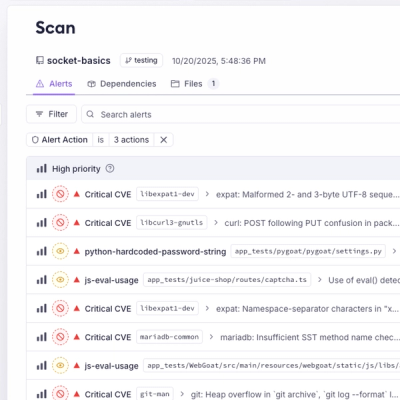
Product
Introducing Webhook Events for Pull Request Scans
Add real-time Socket webhook events to your workflows to automatically receive pull request scan results and security alerts in real time.
v0.3.0 - A simple CSS preprocessor that interprets JavaScript
jsheets file
Jsheets is a CSS preprocessor that executes JavaScript. It also replaces function calls and variables inside CSS. A simple approach to CSS preprocessing.
npm install -g jsheets
$ ObjectInside CSS the whole $ object is availible to you. Because $ is also a function (as explained in the helpers section), you can't write to its arguments, caller, length and prototype attributes.
div {
background: $.someColor;
}
include 'file/directory'
With include you can import files or directories to a jsheet. When you include a directory, it will search that directory for files with the jsheet file extension.
css(string)
With the css function you can output css. So you can do:
css('div {display: block}')
All combined files have the same global scope.
Inside your JavaScript you have the following variables availible to you.
As documented above
Documented in the hooks section
on(hook, function)
on is the function to add functions to hooks. See under the hooks section for examples.
There are some helpers provided inside the $ object.
$(expression)
$ itself is not just an object but also a function that executes and returns what is passed to it. This can be usefull for math or sometimes you can use it to use variables in weird places. Example:
div {
width: $(100 * 30)px
/* WON'T WORK */
width: $.someWithem
/* WILL WORK */
width: $($.someWith)em
}
You cannot use braces inside of a call to $. That's because the $ variables and functions are replaced using a mediocar RegEx.
extend.add(name, attributes)
extend.that(name, selector)
With extend you can reuse css attributes. It has two methods: add and that. With add you create save a bunch of attributes under a name.
$.extend.add('roundbutton', '\
display: block;'
)
Then with extend.that you can then reuse those attributes.
$.extend.that('roundbutton', '.dialogue__button')
$.extend.that('roundbutton', '.escape__button')
What is special about this function, is that it renders only one CSS block per extend.add. So the above renders to:
roundbutton, .dialogue__button, .escape__button { display: block; }
$.calc(calculation)
With calc you can do calculations in css units. You pass it a string. It also does a printf-style replacement with %d.
$.someVar = '4rem'
$.calc('%d / 2', $.someVar)
compilesTo
2rem
In jsheets hooks are simple arrays you can push functions to. They are stored in the hooks object, which is globally availible. Hooks get triggered at a certain point in the parsing process and then the functions stored in a hook array will get executed with certain parameters.
These hooks are executed without an argument, at the and of parsing a file. The return value of a onEOF hook will get printed as CSS.
Extending jsheets is super straigt forward. If you want to add your own helpers, you can just add stuff to the object.
$.myHelper = function () {
css('before: "YEY! I wrote my own helper :OO"')
}
You can also install and require npm modules. Autoprefixer for example
npm install autoprefixer
on('onEOF', require('autoprefixer'))
onAfterParse hooks are the last thing that gets called. They receive the parsed CSS as an argument. Their return value replaces the parsed CSS. This makes it perfect for something like autoprefixer.
I'm pretty ok with the package as it stands right now. But there are a lot of things I plan to implement.
v0.3.0This is still an early alpha, so everything can change
FAQs
A simple CSS preprocessor that interprets JavaScript
The npm package jsheets receives a total of 4 weekly downloads. As such, jsheets popularity was classified as not popular.
We found that jsheets demonstrated a not healthy version release cadence and project activity because the last version was released a year ago. It has 1 open source maintainer collaborating on the project.
Did you know?

Socket for GitHub automatically highlights issues in each pull request and monitors the health of all your open source dependencies. Discover the contents of your packages and block harmful activity before you install or update your dependencies.

Product
Add real-time Socket webhook events to your workflows to automatically receive pull request scan results and security alerts in real time.

Research
The Socket Threat Research Team uncovered malicious NuGet packages typosquatting the popular Nethereum project to steal wallet keys.

Product
A single platform for static analysis, secrets detection, container scanning, and CVE checks—built on trusted open source tools, ready to run out of the box.